Mani Bundle
Who Really Owns Mani Company?
Unraveling the ownership structure of MANI, INC. is key to understanding its position in the global medical and dental markets. Founded in 1959, the company's journey began with a focus on high-quality medical devices, a legacy that continues to this day. But who controls the reins of this publicly traded entity? This exploration delves into the evolution of Mani SWOT Analysis, from its origins to its current status on the Tokyo Stock Exchange.
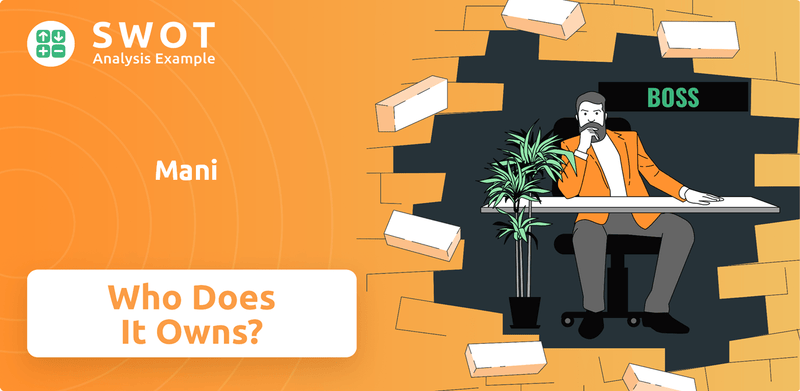
Understanding the Mani Company ownership is crucial for investors and stakeholders alike. As a publicly held corporation, the ownership of Mani Company is distributed among various shareholders, but the influence of key investors and the company's strategic direction are important. This deep dive will explore the Mani Company owner and provide a comprehensive overview of the company's history, including where is Mani Company located and its current financial standing.
Who Founded Mani?
The story of the company begins with Masao Matsutani, who established the business on May 1, 1956, in Takanezawa, Tochigi Prefecture, Japan. Initially, it was a small venture, but it laid the groundwork for a global presence. The formal establishment as MATSUTANI SEISAKUSYO CO., LTD. occurred in 1959, marking a key step in its evolution.
Matsutani's vision centered on creating rust-proof surgical needles using 18-8 stainless steel. This innovation was groundbreaking at the time. The company's early focus on this pioneering product set the stage for its commitment to 'The Best Quality in the World, to the World.'
Upon its reorganization as a limited company, the initial capital was 1 million yen. While specific details about the equity distribution or early shareholders are not publicly available, the company's integrated report indicates that the founding family initially owned the company. The early development benefited from subsidies from the Ministry of Health and Welfare.
Masao Matsutani founded the company in 1956.
The initial capital was 1 million yen.
The company's early development focused on innovative 18-8 stainless steel surgical needles.
The founding family initially owned the company.
The company started in Takanezawa, Tochigi Prefecture, Japan.
Received subsidies from the Ministry of Health and Welfare.
Understanding the early ownership and founding of the company provides context to its long-term strategy. The company's commitment to quality and innovation, starting with the creation of rust-proof surgical needles, has been central to its success. The early support from the Ministry of Health and Welfare highlights the importance of its products. For more insights into the company's strategic approach, consider reading about the Marketing Strategy of Mani.
- Masao Matsutani's vision drove the company's initial innovation.
- The founding family's ownership was key in the early stages.
- The focus on 18-8 stainless steel needles set a precedent for quality.
- Early government support aided in the company's development.
Mani SWOT Analysis
- Complete SWOT Breakdown
- Fully Customizable
- Editable in Excel & Word
- Professional Formatting
- Investor-Ready Format
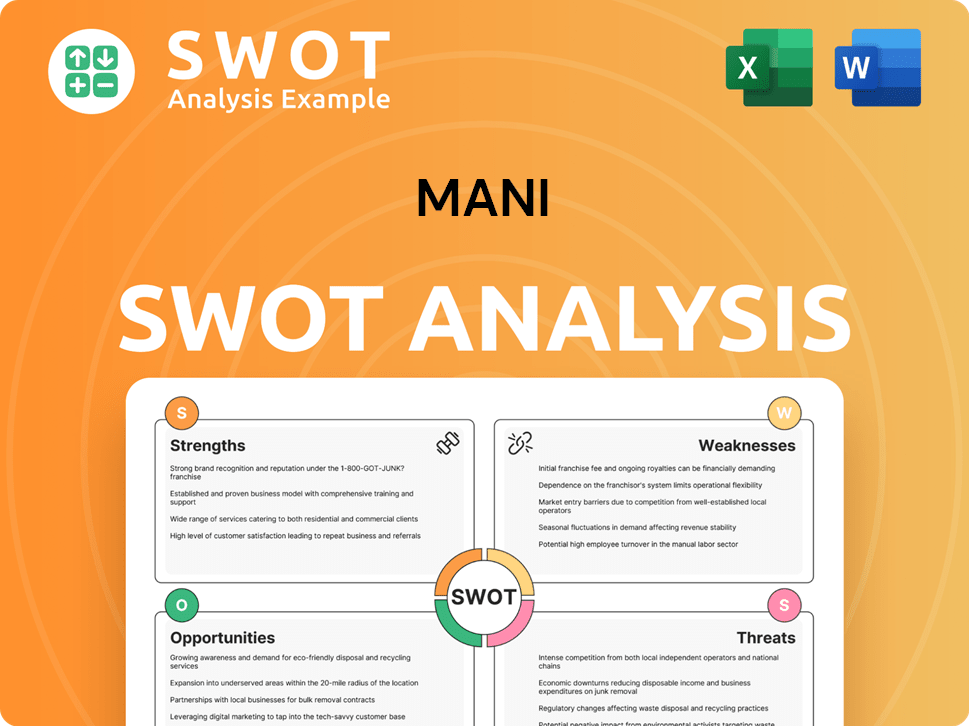
How Has Mani’s Ownership Changed Over Time?
The evolution of ownership at MANI, INC. reflects its growth from a private entity to a publicly traded company. Initially registered with the Japan Securities Dealers Association (JASDAQ), the company later listed on the second section of the Tokyo Stock Exchange. This progression culminated in a move to the first section of the Tokyo Stock Exchange in 2012, signifying increased visibility and access to capital. This transition has significantly shaped the company's ownership structure, attracting institutional investors and broadening its shareholder base. For a deeper dive, you can explore the Brief History of Mani.
As of June 10, 2025, MANI, INC. is listed on the Tokyo Stock Exchange (TYO: 7730). Its market capitalization stands at approximately $816 million, with roughly 98.5 million shares outstanding. This public listing has opened the door for a diverse range of stakeholders, including institutional investors, who now hold substantial portions of the company's shares. The company's journey from JASDAQ to the first section of the Tokyo Stock Exchange is a clear indicator of its expansion and evolution in the market.
| Shareholder | Stake (as of) | Approximate Stake Percentage |
|---|---|---|
| First Sentier Investors (UK) IM Ltd. | November 11, 2024 | 1.31% |
| Nikko Asset Management Co., Ltd. | January 31, 2025 | 1.19% |
| Daiwa Asset Management Co. Ltd. | April 30, 2025 | 1.06% |
| BlackRock Fund Advisors | June 5, 2025 | 1.02% |
The key institutional shareholders, including First Sentier Investors, Nikko Asset Management, Daiwa Asset Management, and BlackRock Fund Advisors, demonstrate the confidence these entities have in the company's potential. The company's financial performance, particularly its revenue, which reached ¥28,513 million (approximately $193 million USD) for the fiscal year ended August 31, 2024, a 16.4% increase year-on-year, has likely influenced these investment decisions. This growth, fueled by overseas sales and the depreciation of the yen, has made the company an attractive investment for these major stakeholders. This data provides insights into who owns Mani Company and the Mani Company ownership structure.
The ownership of MANI, INC. has evolved significantly since its founding, transitioning from private to public ownership on the Tokyo Stock Exchange.
- The company's market capitalization is approximately $816 million as of June 10, 2025.
- Key institutional investors include First Sentier Investors, Nikko Asset Management, Daiwa Asset Management, and BlackRock Fund Advisors.
- The company's revenue for the fiscal year ended August 31, 2024, was approximately $193 million USD.
- The company's growth is fueled by overseas sales and the depreciation of the yen.
Mani PESTLE Analysis
- Covers All 6 PESTLE Categories
- No Research Needed – Save Hours of Work
- Built by Experts, Trusted by Consultants
- Instant Download, Ready to Use
- 100% Editable, Fully Customizable
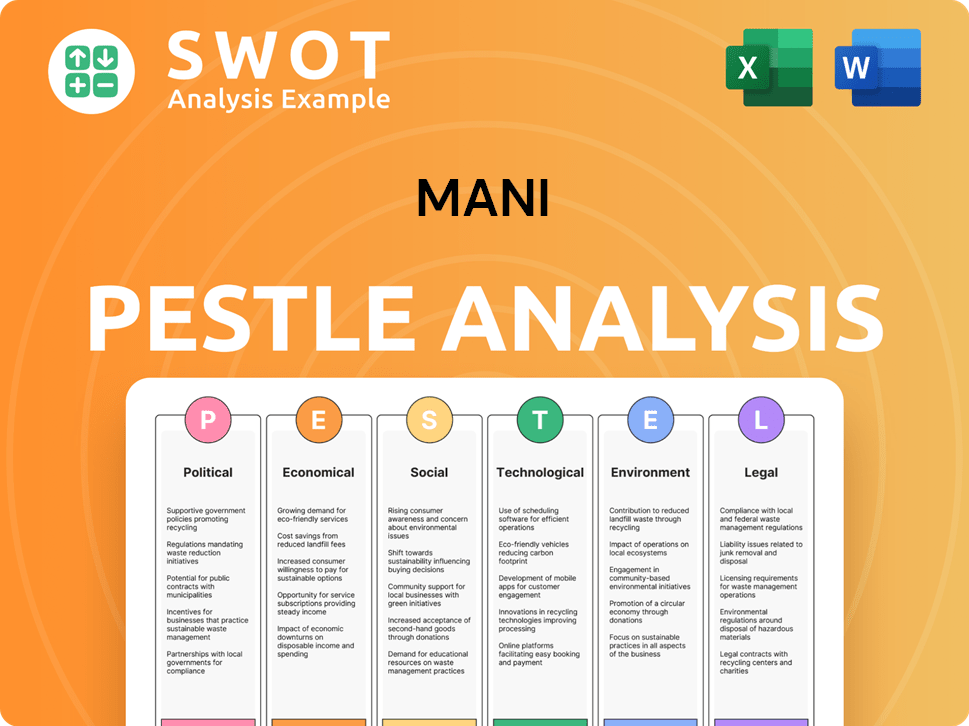
Who Sits on Mani’s Board?
The current board of directors at MANI, INC. significantly influences the company's governance and strategic direction. The company employs a governance structure that includes nominating, compensation, audit, and strategy committees. This setup is designed to separate management oversight and business execution functions effectively. The executive officers handle business operations, while non-executive directors primarily focus on supervisory roles. Understanding Mani Company ownership involves recognizing the roles of these key individuals.
Key executives include Masahiko Saito as Director, Executive Chairman and Chief Executive Officer, Kazuo Takahashi as Director, Executive Vice President and Chief Risk Management Officer, and Masaya Watanabe as Director and Executive Officer. Yosuke Mitsusada serves as Chairman of the Board, and Toshihide Takai as Vice Chairman. Independent directors include Yukiko Moriyama, Yukio Matsui, and Tatsushi Yano. The company's governance structure has been recognized, receiving the METI Minister's Award for Corporate Governance of the Year 2023, highlighting its approach to selecting and succeeding presidents and CEOs. This structure is crucial when considering Who owns Mani Company and the influence of the board.
| Board Member | Title | Role |
|---|---|---|
| Masahiko Saito | Director, Executive Chairman and CEO | Executive Leadership |
| Kazuo Takahashi | Director, Executive Vice President and Chief Risk Management Officer | Executive Leadership |
| Masaya Watanabe | Director and Executive Officer | Executive Leadership |
| Yosuke Mitsusada | Chairman of the Board | Governance |
| Toshihide Takai | Vice Chairman | Governance |
| Yukiko Moriyama | Independent Director | Oversight |
| Yukio Matsui | Independent Director | Oversight |
| Tatsushi Yano | Independent Director | Oversight |
In 2020, a significant shift occurred as all members of the founding family withdrew from management, transitioning leadership to the next generation. This move signals a move towards a more independent governance model, aiming to balance the interests of all stakeholders. This change is a crucial aspect of understanding Mani Company owner and the evolution of its corporate governance. For additional context, consider the Target Market of Mani.
The board structure emphasizes independent oversight and strategic direction.
- Executive leadership is distinct from supervisory roles.
- Independent directors play a key role in governance.
- The company has received awards for its governance practices.
- The transition from founding family management reflects a move toward broader stakeholder focus.
Mani Business Model Canvas
- Complete 9-Block Business Model Canvas
- Effortlessly Communicate Your Business Strategy
- Investor-Ready BMC Format
- 100% Editable and Customizable
- Clear and Structured Layout
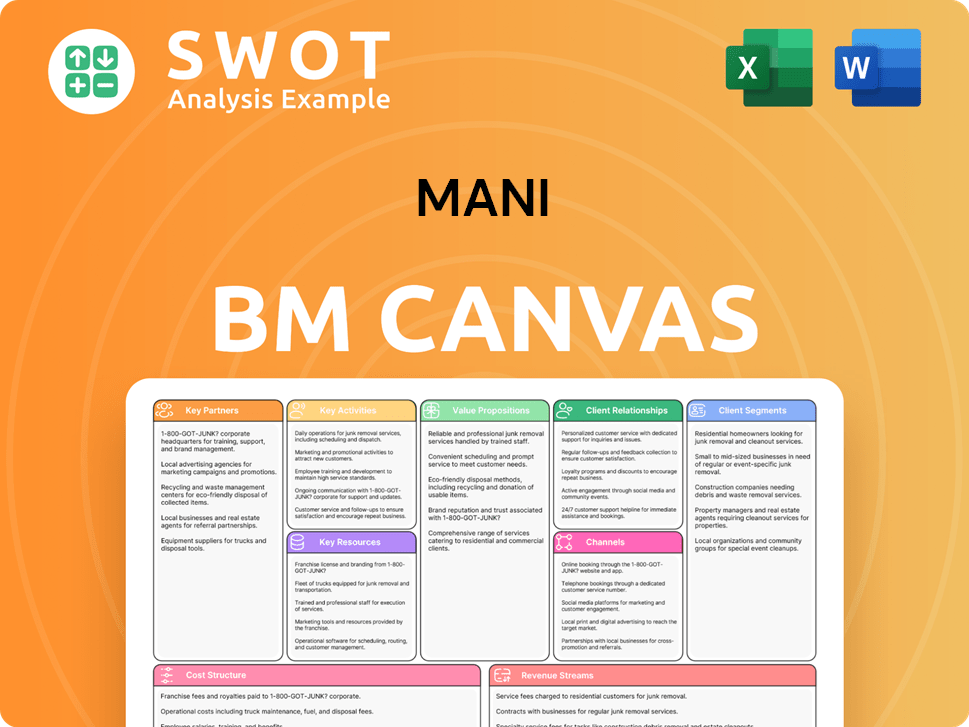
What Recent Changes Have Shaped Mani’s Ownership Landscape?
Over the past few years, the ownership profile of MANI, INC. has been shaped by significant strategic moves. A key development is the expansion of its global footprint, particularly the establishment of MANI MEDICAL AMERICA INC. (MMA) in June 2024, set to begin operations in January 2025. This subsidiary, wholly owned by MANI, INC., with a capital of USD 1 million, aims to bolster sales and market presence in North America, where sales previously accounted for only about 10% of consolidated net sales.
The company's financial performance in FY2024 showed a strong rebound, with net sales reaching ¥28,513 million, up 16.4% year-on-year, and operating income at ¥8,392 million, up 15.8% year-on-year. Profit attributable to owners of parent was ¥6,286 million, up 5.6% year-on-year. This indicates a positive trajectory for the company. Further insights into the company's strategic direction can be found in the Growth Strategy of Mani.
| Metric | FY2024 | FY2023 |
|---|---|---|
| Net Sales (¥ million) | 28,513 | 24,509 |
| Operating Income (¥ million) | 8,392 | 7,247 |
| Profit Attributable to Owners (¥ million) | 6,286 | 5,953 |
Leadership changes also reflect a shift in ownership influence. Masaya Watanabe, an outside director, was appointed as the new President and Representative Executive Officer in November 2024. This follows the complete withdrawal of the founding family from management roles in 2020. The company's medium-term management plan, initiated in the fiscal year ended August 31, 2022, emphasizes globalization of sales, production, and development functions, aiming to transform into a 'true global company'.
The current ownership structure of Mani Company reflects a transition away from founding family influence. The company is focused on global expansion.
Ownership is now primarily institutional and likely held by a diverse group of investors. The company is not a public company.
The primary owner is likely a combination of institutional investors and potentially private equity firms. The company is not a public company, so the owner is not the public.
Mani Company has a long history, with recent developments focusing on global expansion and leadership changes. The company headquarters is in Japan.
Mani Porter's Five Forces Analysis
- Covers All 5 Competitive Forces in Detail
- Structured for Consultants, Students, and Founders
- 100% Editable in Microsoft Word & Excel
- Instant Digital Download – Use Immediately
- Compatible with Mac & PC – Fully Unlocked
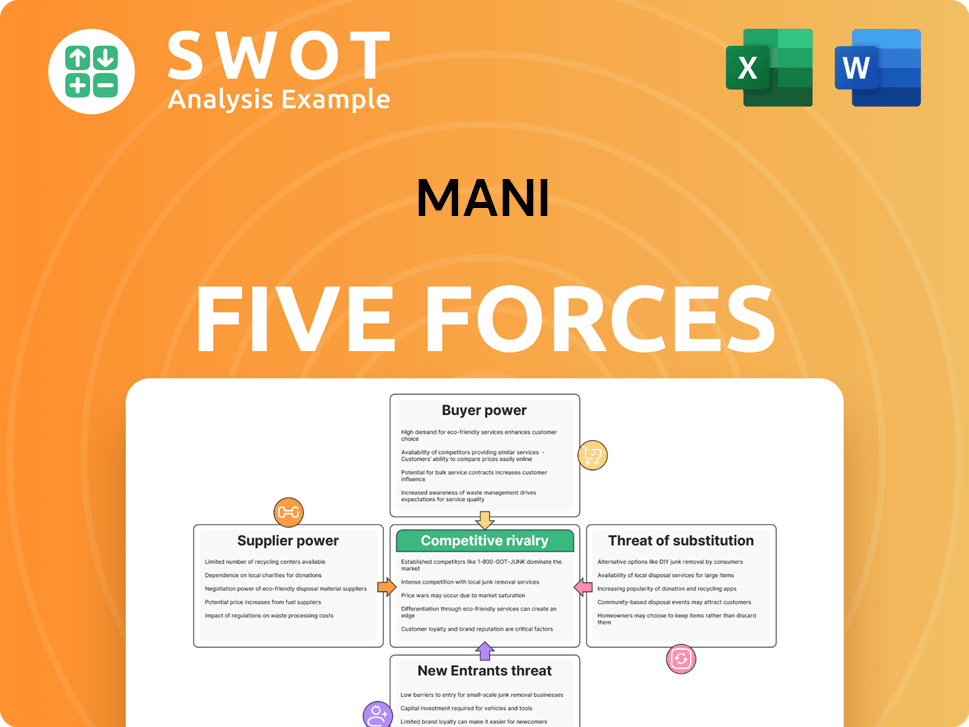
Related Blogs
- What are Mission Vision & Core Values of Mani Company?
- What is Competitive Landscape of Mani Company?
- What is Growth Strategy and Future Prospects of Mani Company?
- How Does Mani Company Work?
- What is Sales and Marketing Strategy of Mani Company?
- What is Brief History of Mani Company?
- What is Customer Demographics and Target Market of Mani Company?
Disclaimer
All information, articles, and product details provided on this website are for general informational and educational purposes only. We do not claim any ownership over, nor do we intend to infringe upon, any trademarks, copyrights, logos, brand names, or other intellectual property mentioned or depicted on this site. Such intellectual property remains the property of its respective owners, and any references here are made solely for identification or informational purposes, without implying any affiliation, endorsement, or partnership.
We make no representations or warranties, express or implied, regarding the accuracy, completeness, or suitability of any content or products presented. Nothing on this website should be construed as legal, tax, investment, financial, medical, or other professional advice. In addition, no part of this site—including articles or product references—constitutes a solicitation, recommendation, endorsement, advertisement, or offer to buy or sell any securities, franchises, or other financial instruments, particularly in jurisdictions where such activity would be unlawful.
All content is of a general nature and may not address the specific circumstances of any individual or entity. It is not a substitute for professional advice or services. Any actions you take based on the information provided here are strictly at your own risk. You accept full responsibility for any decisions or outcomes arising from your use of this website and agree to release us from any liability in connection with your use of, or reliance upon, the content or products found herein.